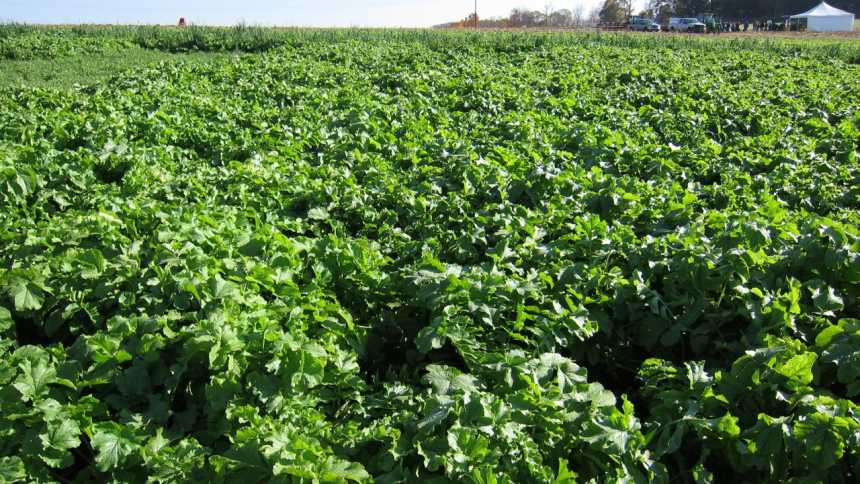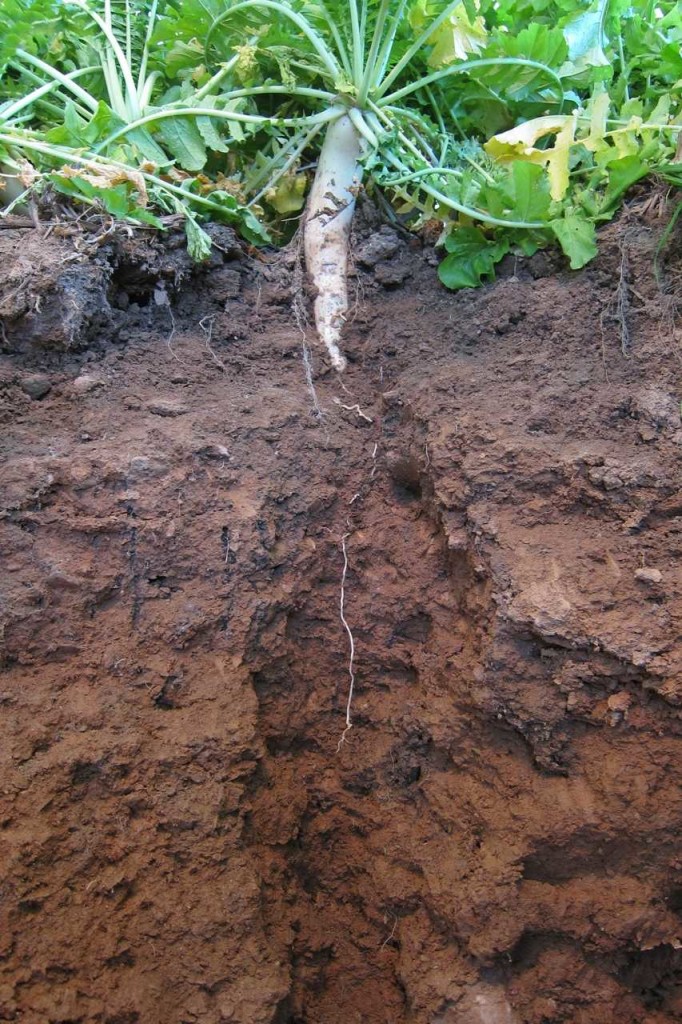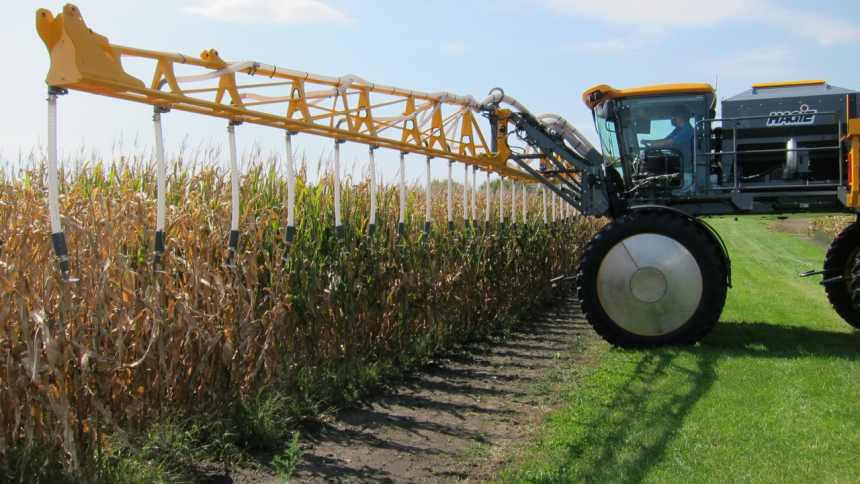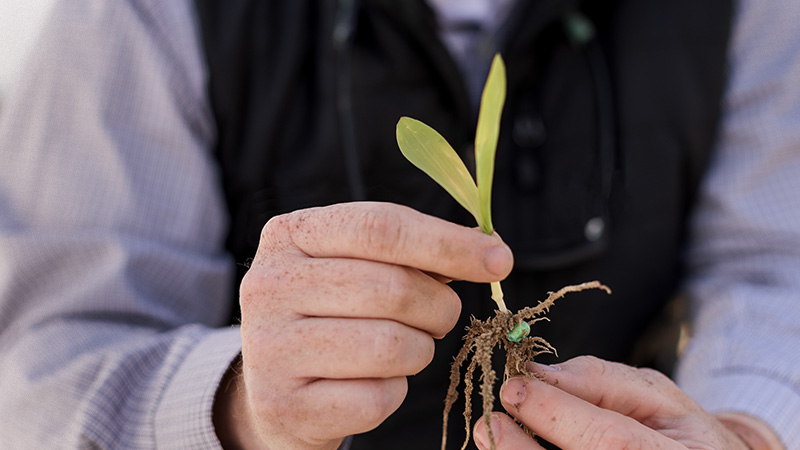Cover Crops’ Part In Protecting Water

A field of established radish cover crop on a test plot.
Admittedly, cover crops can require careful management, and their use to prevent nutrients from entering water sources is not yet widespread. The 2012 Census of Agriculture puts the number of acres utilizing them at 10.3 million, actually less than 5% of total row crop acreage.
But adoption is growing. The gains are coming, in part, as states that have been identified as contributors to water problems implement their EPA-mandated Nutrient Reduction Strategies. In Iowa, for instance, cover crops have become one of the latest tactics growers are using to stop nutrients from leaving fields. Matt Lechtenburg, water quality coordinator for the Iowa Department of Agriculture and Land Stewardship and point person for the state’s Agriculture Water Quality Initiative, says so far, assistance monies there have focused largely on cover crops. “It’s one of the only practices that offers significant reduction in both nitrogen and phosphorus loss,” he says.
In fact, studies coming out of Iowa have shown cover crops can reduce nutrient loss by 40% to 50% in fields, a pretty significant step in meeting federal nutrient management goals.
In efforts in the East over the last 20 years, growers in the six states that make up the Chesapeake Bay watershed have made huge investments in mitigation techniques such as cover crops, grassed waterways for drainage, wildlife buffers on field edges and water control structures for storm events, reports Mike Twining, vice president of sales and marketing with Willard Agri-Service. In 2010 a new record was set when 1,668 farmers in Maryland alone planted more than 500,000 acres of cover crops.
Multiple Benefits
Cover crops have much more to offer than just helping to deter nutrient movement. Many growers use them simply to keep soil from eroding and keep the fertilizer they paid for available to their star crops, says Dr. Robert Myers, North Central Region director of the Sustainable Agriculture Research and Extension (SARE) program. They’re also seeing advantages in overall soil health, including increased activity of beneficial soil organisms and earthworms. With better access to water and nutrients, cash crops can root more deeply, and soil compaction is reduced. Cover crops can also improve weed control, preserve moisture and increase the availability of free nitrogen through soil fixation by legumes and others.

A corn crop will send some of its roots down the same root channel created by this radish taproot, deep into the soil.
However, one big question for growers remains: Do the crops increase yields and hence, profits? The 2013-14 Cover Crop Survey Report says yes. Released by the Conservation Technology Information Center (CTIC) in conjunction with SARE, it shows that 639 of the 1,924 respondents provided data comparing corn yields on similar fields with and without cover crops. They noted an average yield increase of five bushels per acre — or 3.1% — on fields that had been planted to cover crops before corn. In soybeans, 583 farmers reported an average boost of two bushels per acre, or 4.3%.
Robert Bellm, extension educator in south central Illinois is doing work to bring cover crops to Illinois and prove their worth there. He’s three years into a multi-year Illinois Nutrient Research Education Council project to quantify benefits. “The profitability question hasn’t been answered yet,” he says. “It depends on how much value you put on the sequestered nitrogen or on reduced soil erosion.
“If you’re talking profitability because of increased crop yields, I think that would be pretty questionable. In many cases, we don’t see a consistent positive yield response to cover crops,” he’s found.
Tyler Grain and Fertilizer, Smithville, OH, has seen increasing interest among customers over the last three years. Dustin Ramsier, CCA and agronomist, says 10% of customers are beginning to ask questions about benefits, costs and options for cover crops — and they have special interest in the practice’s ability to improve soil health.
Listing Challenges
The biggest challenge growers face with cover crops is getting them established in the fall, say experts CropLife® magazine contacted. First is the time issue. Farmers are busy, harvesting and getting their fall field work done, says Myers.
Then too, corn and soybean maturity and weather can hinder establishment. Bellm says in his region, cover crops have to be planted in early September, to have time to get established. If the main crop is still in the fields, cover crop seeding needs to be done into that standing crop. “The standing crop has to be senescencing or ripening so the sunlight can get down to the surface so that the cover crop seedlings can become established,” he explains. Adequate rainfall is also needed.
“If you wait until late September or even early October, there’s not enough warm growing period after the seed is down for the cover crop to become established and grow enough to provide a benefit,” says Bellm.
Myers adds that there have been some issues with broadcast seeding, whether from an airplane or other methods, in getting consistent establishment. Through research and farmer experience, people are figuring out better how to do it, he says.
Terminating the cover crop at the right time can also be a challenge. Bellm explains that if the plants get too mature, they may dry out the soil or tie up the nitrogen needed by the corn crop.
Cover crops can be terminated with a non-selective herbicide. Some types can be killed by rolling and crimping, a practice common with cereal rye and sometimes, hairy vetch.
As for the numbers, Myers says his team has surveyed farmers about how much cover crops cost them — on average it’s about $25 per acre for seed; $12 for an outside company to seed (by ground or air); plus a possible extra herbicide application to kill the crop in the spring.
In general, perhaps the biggest factor to consider is that this practice is a long-term investment, said experts.
“I personally feel that it’s very hard to see a dollar value from cover crops in the first few years,” says Ramsier. “It is definitely an investment in improving the soil you work with. The exception would be a drought year following a full cocktail of cover crop. They could offer a considerable advantage that could result in higher yields due to water holding-capacity in the soil. But ultimately we are looking for improved soil health, which again will translate to higher yields and/or reduced inputs if organic matter values can be increase over time.”
Myers offers a somewhat different perspective. “There is a perception among some that cover crops are too expensive, but our survey data has shown that cover crops often do pay for themselves. This was particularly the case in the drought of 2012, but even in 2013, farmers who had used cover crops for two to three years were covering their costs or making money off cover crops. It’s true the first year a cover crop is used may not be an immediate net return, so it’s more of investing in the future crop returns and soil health.
Gary Farrell president and CEO of Ag Enterprise Supply, Cheney, WA, also emphasizes to growers — and to absentee landlords, farm managers and financial institutions — that the practice is an investment. Many only look at it in the short-term return,
he says.
Cover crops are, in fact, still very new to the Northwest, so Farrell and other savvy retailers, as well as the Pacific Northwest Direct Seed Association, are trying help with education in the region. Two key potential applications for the area are crops following dryland winter wheat and after potatoes (especially to reduce soil erosion from wind).
Advice For Growers And Retailers
Myers recommends that if growers want to try cover crops, they should start with a simple system. For example, they should use crops that will die over the winter. And if they’re going to plant corn the next season, they could use something like radishes and oats. They could interseed the radish and oats into soybeans before harvest — or after soybeans are harvested, they could drill in the oats.
Cereal rye does not winter kill, but it’s a very proven system before soybeans and works in a corn/soybean rotation, says Myers. Cereal rye is also used in many other crops, such as cotton.
Retailers have some great business opportunities in helping growers utilize cover crops, says Myers. First, in the CTIC survey, farmers said they wanted dealers to help them document and monitor their soils’ health. Dealers could assess and understand soil changes resulting from cover crop use, then adjust nutrient management plans to account for cover crop nutrient contributions.
Another business possibility is to carry the seed and provide technical assistance in selecting which varieties to use.
“I try to supply as much information to growers, not to overwhelm them, but to allow for them to come to their own conclusion as to what they want to accomplish with a cover crop,” says Tyler Grain’s Ramsier.

The Hagie Cover Crop Interseeder allows applicators to convert high clearance rigs for cover crop seeding.
Ag Enterprise Supply already sells seed and a lot of pasture and CRP blends. Farrell says it would be a good fit for his company to bring cover crop seed to the farmer. “We could even find ways for them to produce it,” he speculates.
Then there’s the service of seeding the crops in fields. In fact, Hagie has introduced a kit to convert its high clearance sprayers into seeders for cover crops. The kit costs $40,000, but Myers says it pays off pretty quickly. “If retailers are making $12 an acre to seed the cover crop, and Hagie units can do 300 to 400 acres per day, they can pay them off in a season or two,” he calculates.
Retailers could also provide cover crop termination, if winter kill varieties are not used.





